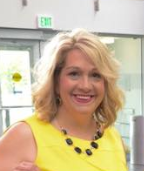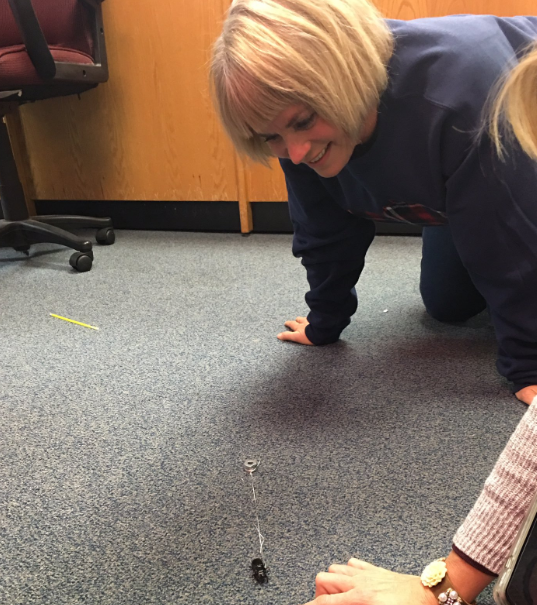For STEM teachers, choosing the best professional development (PD) opportunity from myriad offerings can be challenging: Does the session pertain to my specialty? Will it speak to my students’ needs? Can I fit it into my crowded schedule? One new PD opportunity aims to answer those questions and others — right in the classroom. The Next Generation STEM Classroom project offers participating educators the chance to watch a master teacher instruct their students at their school during regular class hours. Afterward, the educators discuss the lesson with the master teacher to gain further insights. This PD opportunity is coming to Ohio via the Center for Integrative Natural Science and Mathematics at Northern Kentucky University. Ella Bowling, STEM outreach director at the center, in Highland Heights, Kentucky, gave us the details:
Q: Tell us about your background in education and your work at the Center for Integrative Natural Science and Mathematics (CINSAM).
 A: I have served as the STEM outreach director at CINSAM since 2017. Prior to that, I worked for one year as CINSAM’s middle school outreach specialist.
A: I have served as the STEM outreach director at CINSAM since 2017. Prior to that, I worked for one year as CINSAM’s middle school outreach specialist.
In addition, I have 12 years of experience as a seventh-grade science teacher with Mason County Schools in Kentucky. I was named the 2012 Kentucky Middle School Science Teacher of the Year and was a semifinalist for the 2014 Kentucky Teacher of the Year.
Q: What is the Next Generation STEM Classroom project — how did the concept come about, how does it work and why is it effective?
A: CINSAM offers the Next Generation STEM Classroom (ngSC) project — an embedded STEM education professional development (PD) program — in more than 25 school districts across northern, central and western Kentucky.
The project was initiated in 2012 and is led by CINSAM’s STEM outreach director and an outreach specialist who guide a team of master teachers. The master teachers, who are former teachers from the Greater Cincinnati region, regularly work with schools to offer PD aligned with the Kentucky Academic Standards (mainly for science, but also mathematics and English language arts) and, more broadly, best practices in teaching.
The program is embedded, meaning that the participating teachers attend the training during a regular school day in a classroom with their own and colleagues’ students. In the ngSC, master teachers conduct PD sessions with teachers from multiple-grade-level groups four times during the school year. Each session comprises two segments.
During the first segment, the master teacher models best practices while teaching a STEM lesson to students in their regular classroom. The PD participants are positioned around the room so that they can observe the teaching episode as it happens. This segment is known as the “Fishbowl” and is a unique feature of the PD model, offering teachers the rare opportunity to experience PD embedded in their own school district’s context and with their own students. ngSC teachers can observe, in real time, how students take up, and respond to, the model’s strategies. In this way, the ngSC model provides teachers a “proof of concept” — a form of evidence that is authentic and convincing, as opposed to coming from researchers or other stakeholders.
Once the class is over, the teachers and CINSAM master teachers meet for the second segment, the “RECAP,” or “Reflection, Exploration of Content, Alignment and Pedagogy.” During this segment, participants reflect on the best practices they observed in the Fishbowl, explore science content, discuss how these best practices and content can be aligned to their own classrooms with applicable state standards, and delve into the facets of high-quality pedagogy.
 After attending the PD, teachers and curriculum specialists share the lessons with their students and disseminate the principles learned in the ngSC to the non-attending teachers in their buildings (we call these teachers “indirect participants”).
After attending the PD, teachers and curriculum specialists share the lessons with their students and disseminate the principles learned in the ngSC to the non-attending teachers in their buildings (we call these teachers “indirect participants”).
This teacher-led professional learning community model not only utilizes participating teachers and administrators in a network aimed at training other teachers, but also provides other material resources. These include an online resource space, video recordings of each Fishbowl and RECAP session and numerous lesson materials provided by CINSAM master teachers.
The ngSC PD utilizes the “5E Learning Cycle” in lesson creation. This method of inquiry, especially as it integrates across STEM, supports deep learning by students.
The cycle starts with “Engagement” so that students are immediately “hooked” and able to connect the material to their own context. It then moves to “Exploration” and “Explanation,” where students form questions and hypotheses and embark on making their own discoveries while constructing their own knowledge.
With the fourth E, students “Extend” what they’ve learned to generalize more broadly and connect with previous learning. Finally, students “Evaluate” and demonstrate their learning through writing or other assessment methods.
The ngSC master teachers have also incorporated phenomenon-based instruction in the past year to make this 5E process even more integrative, engaging and relevant to students.
Q: Where have you used this method of professional development, and what changes have you made in it based on feedback and other factors?
A: Since stepping into the director role in 2017, I have led several changes for our program based on teacher feedback at the end of each year.
Teachers have consistently asked for electronic versions of the lessons we teach through the ngSC. We have established Google Drive folders for all of our lessons making sharing them with teachers easy and convenient. We also adjusted the lessons to be more closely aligned to what teachers are teaching in their classrooms.
In addition to these changes, we have brought more schools in other Kentucky regions into the project, expanding from 20 districts to 28 in 2017-18. We also conducted a similar program for schools in the Roman Catholic Archdiocese of Cincinnati throughout 2017-18 with great success.
Q: Tell us about the grant you received and how you plan to use the money to expand your Next Generation STEM Classroom concept into Ohio.
A: Our $15,500 grant from the Martha Holden Jennings Foundation will be used to replicate this process with our friends from the Greater Cincinnati STEM Collaborative (GCSC) and schools in the Greater Cincinnati region.
The GCSC is recruiting schools for the Ohio STEM PLC project. The collaborative will work with school and district administrators to recruit the first cohort of teachers for the project.
STEM lab teachers will be selected primarily from five school districts that have made early efforts to establish STEM labs in support of students mastering Ohio science (and technology) standards. STEM lab teachers from these districts have voluntarily participated in a GCSC-sponsored interest group during the past year with district administrators demonstrating increasing support for these new learning environments.
Cohort space permitting, teachers might also be recruited from other districts with STEM labs, or from districts that have an interest in establishing such facilities and providing instruction. Because a school often has only one STEM lab teacher, the cohort will provide mutual support among these teachers within and across districts in southwestern Ohio.
Q: Will your approach to your concept change based on any educational standards that might be exclusive to Ohio?
A: All of the lessons we are using in our Ohio STEM PLC project will be aligned to Ohio science standards and are designed for this program. We are targeting sixth grade as the level where the lessons will be taught, and we will be sharing resources for fourth through seventh grades in all of our sessions.
Q: Are you planning other sessions in Ohio? How can educators find out more about the Next Generation STEM Classroom and how they might participate?
A: After this year, we hope to expand the program in Ohio schools. If administrators would like to bring this project to their districts, they can reach out to me at CINSAM. My email is [email protected], and my office number is 859-572-1933.